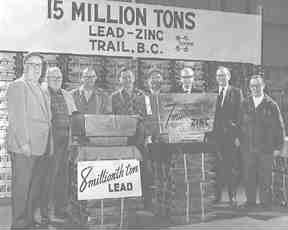When Cominco sent John Hamilton to Kimberley, B.C., in 1976 to work as chief geologist at the Sullivan mine, the province’s mining industry was vibrant. Exploration projects were under way, for which money was being raised on the Vancouver Stock Exchange. Companies both large and small were out and about looking for capital.
Moreover, drilling success at the Red Dog zinc mine in Alaska meant that Cominco would remain a leader in zinc production.
“The company’s future looked secure,” recalls Hamilton.
Twenty-five years later, the industry is far from vibrant. And while the future of Cominco (now Teck Cominco) and the Red Dog mine still look solid, the Sullivan mine is quickly coming to a close.
In a ceremony slated for early November, the mine will be decommissioned. A series of events will mark the closing for more than 200 guests expected to attend.
Hamilton and his wife, Betty, brought their two children to Kimberley and spent the next eight years watching them grow up. They were among four generations of families who drew their livelihood from mining and milling complex ores from Sullivan.
The venerable mine got its start more than a century ago, in 1892, when Patrick Sullivan and three partners, John Cleaver, E.C. Smith and W.C. Burchett, were prospecting in the East Kootenay region.
They found themselves out of food when they reached a mission at Fort Steele, B.C. A local priest fed the men and helped them procure supplies at the fort. Upon hearing news of a great strike at the North Star mine, a few miles away, the party decided to prospect the opposite side of the valley. They discovered rich float on the first day, and after tracing it to its source, they staked what would become the Sullivan mine.
Mining started in 1895 by Canadian Smelting Works, which operated the property until it was sold to the Le Roi group from Spokane, Wash., in 1896.
Operations were enhanced by completion of the Canadian Pacific Railway (CPR) branch line to Kimberley in 1899. The new owners operated the property as the Sullivan Group Mining Co. and built a smelter at nearby Marysville in 1903.
However, ore was difficult to treat, and the mine was forced to shut down in 1907. Two years later, it was acquired by Federal Mining & Smelting and, through a subsidiary, leased to Cominco, a subsidiary of CPR. In 1910, Cominco exercised its option and completed the purchase in 1913.
Developing a metallurgical process to treat the complex lead-zinc ores took considerable time. A concentrator was erected at Chapman Camp, about two miles away, and was put into operation in 1923. The concentrates were then shipped to the smelter at Trail, B.C.
Over the next decade, the facilities at the smelter were greatly expanded to include a slag fuming plant for the recovery of zinc, as well as sulphuric acid/fertilizer, bismuth and cadmium plants.
From 1913 to 1979, the mine produced more than 123 million tons containing 2.4 oz. silver, 6.8 % lead and 5.9% zinc per ton.
As chief geologist, Hamilton was responsible for local and regional exploration for new prospects.
“In the ’60s, holes two or three feet long by one-and-a-quarter-inch diameter were drilled into pillars, and triaxial strain indicators were imbedded in them in molten sulphur,” he explains. “Monthly triaxial resistivity measurements over several months permitted tracking strain as pillars took weight. Then the holes were carefully overdrilled with 6-inch-diameter core to relieve stress and get final ‘zero’ measurements on the indicators.”
This process resulted in a few meters of prized “hollow log” massive sulphide core, as Hamilton describes it, which was slabbed into two-inch thick “wafers” — ideal for bookends; in fact, Hamilton ended up with a couple of sets.
“I don’t exactly miss working at the mine,” says Hamilton, now retired and a grandfather, “but Betty and I do look back on our time in Kimberley with many fond memories.”
They are not alone.


Be the first to comment on "Remembering the Sullivan mine"